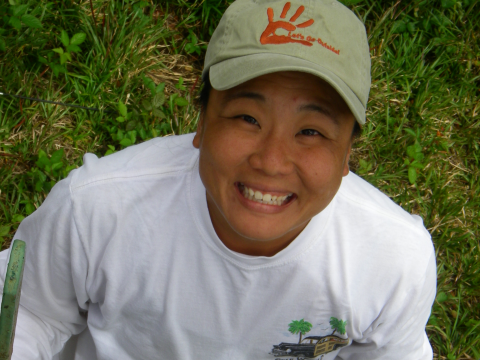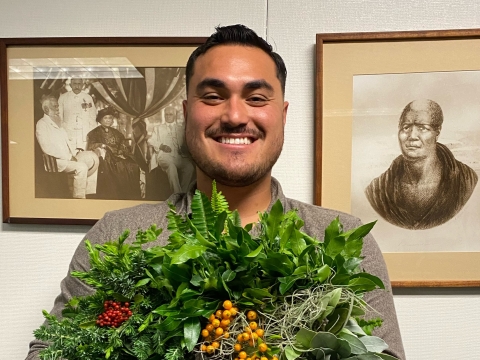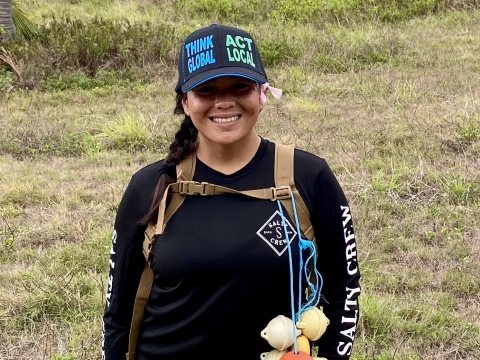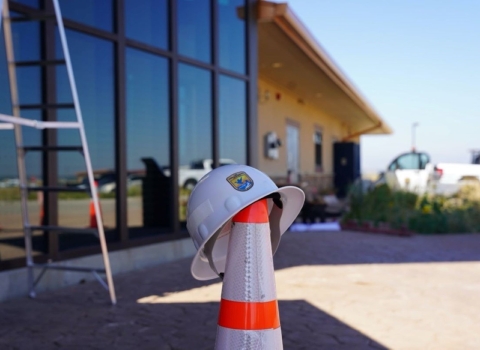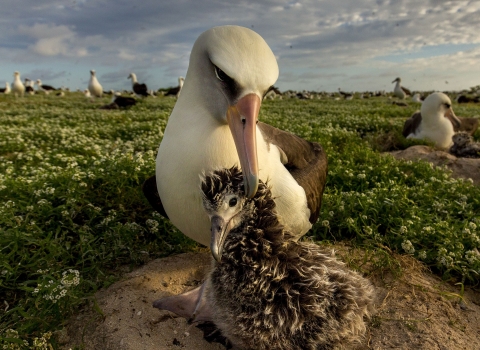In honor of Asian American, Native Hawaiian, and Pacific Islander Heritage month, we would like to highlight some of our employees from the U.S. Fish and Wildlife Service Pacific Islands Fish and Wildlife Office and the Pacific Islands Refuges and Monuments Office.
Caitlin Shishido
Current biologist/data manager with the Inventory and Monitoring team based out of the Pacific Islands Refuges and Monuments Office in Honolulu, Caitlin Shishido was born and raised on the island of Maui in Wailuku. A yonsei or fourth-generation Japanese American; her great-grandparents came to Hawaiʻi in the late-1800’s/early 1900’s to work on the sugar plantations. Her parents and grandma who was a retired science teacher always encouraged her to be curious about everything. She was lucky enough to grow up with endless hours of exploring the tide pools in her grandparents backyard. She grew up playing in nature – fishing off the breakwater in Hilo Bay, listening to forest birds while hiking in Hosmer’s grove, and watching the sunrise from inside Haleakala crater.
“I feel like I took it all for granted until I moved to the mainland for college. Until I went away, I wanted to be a medical doctor but every time I came home, I found myself wanting to spend as much time outdoors as possible – hiking, diving, being on the beach.”
During one trip home she went diving with her dad who grew up spear fishing in Lahaina. They went to dive at one of his spots and the reef just wasn’t what it used to be - it was barren, there were barely any fish and the coral looked broken and dull. This wasn’t the reef her dad had described.
“I think that’s the moment I realized that I didn’t just want to do science, I wanted to do conservation. I realized that what made home the most special, besides my family and friends, was the environment and I wanted to make sure that my own children would still be able to enjoy the beauty of their island home as much as I have.”
“While I believe that everyone should be responsible for caring about the land and ocean that they live on, I think it’s especially important for those who are part of the AANHPI community in Hawai‘i to be involved, because representation matters. It’s important for our children to see people who look and talk like them, taking responsibility for their home and the greater natural world around them.”
Joy Browning
Joy Hiromasa Browning is a Fish and Wildlife Biologist at the Pacific Islands Fish and Wildlife Office in Honolulu. Her parents are from Kōloa, Kaua‘i and Honolulu. She attended McKinley High School and the University of Minnesota, Twin Cities. Growing up, she enjoyed being outside, playing with the dogs, fishing, hiking, camping, and gardening. But most of all, she enjoyed listening to stories from her family and friends about when they were growing up.
In Hawai‘i, there is a local culture which is a mixture of different parts of all the cultures; this is why Hawai‘i is commonly referred to as the “melting pot of the Pacific.” So, although Browning is ethnically Chinese and Japanese, she describes her background as a mixture of Asian and Polynesian culture.
“The similarities in both cultures of how food is so important and brings joy to people influences my passion for conservation, seeking the balance of humans and nature.”
Her favorite ʻōlelo noʻeau (Hawaiian proveb) is ‘aʻohe pau ka ʻike i ka hālau hoʻokahi (not all knowledge is learned in one school). To her this means that learning comes from many different people, perspectives, and places, and we should be open to listening to others.
Kilo Ka‘awa-Gonzales
Kilo Ka‘awa-Gonzales was born and raised on Molokaʻi with subsistence hunting, fishing, and farming as a way of life. He went to Kula Kaiapuni o Kualapuʻu (a Hawaiian immersion elementary school) and is a proud graduate of Moloka‘i High School. He is of Hawaiian, Filipino, Puerto Rican, and Cuban descent. Something that was prominent throughout his upbringing was the various food he was raised on, ranging from squid lūʻau, poi, pinak bet, pasteles, gandule rice, and congri. “The mixing pot that is Hawaiʻi is a prime example of elevating everyone’s unique skill and identity to create something that can best be described as aloha. Bringing our individualities to the table to make for a bright and strong family.”
Ka‘awa-Gonzales is the Cultural Liaison at the Pacific Islands Fish and Wildlife Office in Honolulu where he has the opportunity to work with all of the indigenous Pacific Islander communities the office supports.
“Growing up, I saw a lot of my local Molokaʻi mentors in conservation agencies who had decades of on-the-job experience and a wealth of conservation knowledge but limited to no higher education degrees, which inhibited them from attaining high level supervisory/managerial positions. This sparked a fire in me and many in my generation to pursue higher education in the field of conservation so we can have access to these decision-making positions and be able to be a voice of many underrepresented communities at these decision-making tables concerning the ethical management of our precious natural and cultural resources. It is extremely important to advocate for local and indigenous resource users, who have innate cultural and subsistence connections to the resources we as agency employees are charged to steward.”
Chelsie Javar-Salas
Chelsie Javar-Salas grew up in a small town called Nāʻālehu in the moku (district) of Kaʻū on the island of Hawaiʻi and currently lives in ‘Aiea on Oʻahu. She went to school at Pahala Elementary and graduated from Kaʻū High School. Growing up, she loved playing outside, whether it was riding her bike in the streets with friends or gardening with her mom or working on her family’s coffee farm in Kona. She spent her weekends and summers planting coffee trees, pulling weeds, and picking coffee with her family.
“Though, farm life is tough I often see conservation and restoration through the same lens; the physical demands required in farming are similar to those needed to restore habitat and recover endangered species.”
Javar-Salas is a Fish and Wildlife Biologist on the Hawaiʻi and Maui Nui Island Team in the Pacific Islands Fish and Wildlife Office. She works on all sections of the Endangered Species Act including consultation, recovery, and critical habitat designation. She has a passion for connecting with the community to recover federally listed plants and their habitats by empowering landowners to malama ʻāina (take care of their land).
“Native Hawaiians have this beautiful ‘ōlelo noʻeau–he ali‘i ka ʻāina; he kauā ke kanaka, which means the land is chief; people are its servant. ‘Āina or land is paramount to life. Being raised on an island, I am cognizant of the finite resources and the need to conserve them otherwise they will be lost forever. Growing up, we are taught to use only what is needed and to never take too much or waste it. These values of mālama ʻāina are what stems my passion for conservation. This ʻāina has raised many generations and we need to continue to mālama ʻāina so that many more generations can continue to thrive here in Hawaiʻi. We must work together to achieve this common goal.”
Jihan Younis
Jihan Younis is a native of Saipan, a tropical island in the western Pacific Ocean, and part of the Northern Mariana Islands. Her mom is Chamorro and Refaluwasch and her dad is Filipino. Saipan is a very special place with a diverse group of people, culture, languages, and food that makes life a unique experience. Life is simple there; everyone knows everyone. You are not just raised by your family or your elders, you are raised by the whole village, a village where relationships matter.
Younis received a master’s degree from the University of Texas -El Paso in Communications and Environmental Conservation and Social Change alongside ten other Micronesians through the Rare Pride Micronesia Program. The program left a profound impact on her career. Much of her career has been managing coral reef education and outreach for the local government. As an indigenous Park Ranger for the Mariana Trench Marine National Monument, she is proud to continue serving her island community.
“No one cares for the land and sea better than the indigenous community that lives, breathes, and thrives in harmony with it. We share deep cultural connections to the land and sea, playing a crucial role in our traditions, livelihoods, and overall well-being shaping our practices of fishing, farming, and conservation. We are the first and greatest caretakers of our environment.”
Younis feels it is her responsibility to protect and preserve this unique marine ecosystem and honor cultural connections to the Monument. Her cultural heritage taught her deep respect for the land, sea, and her elders.
“I am grateful I get to represent my community and be their voice at the table where representation matters. The best part of my job is showing that everyone counts. Being seen and fostering dialogue with our communities is important.”
Her goal is to remove barriers to knowledge of the Monument at the local level and engage communities in conservation.
“I want our kids to see themselves in me, in a position that has been traditionally white dominant. I want to be able to tell our stories from the hearts and minds of our people that can make a meaningful connection to the communities I serve across the Mariana Islands.”
Raina Taitingfong
Raina Taitingfong was born and raised on the beautiful island of Guahan and she is proud to be a Chamorro woman currently working in the field of conservation. She went to Seattle University and majored in Biology. It is important to her to be able to learn and grow from different experiences and bring that knowledge back home to help improve her island community. After graduation, she returned home to work as a Wildlife Biologist for the Guam Department of Agriculture Division of Aquatic and Wildlife Resource for almost 7 years. She worked directly with Ko’Ko’ and Sihek and helped to create a naturalized population of critically endangered species native to Guahan.
Taitingfong currently works as a Wildlife Refuge Specialist at the Pacific Islands Refuges and Monuments Office in Honolulu where she is able to support conservation of the natural resources in Hawai‘i, Guam, CNMI, and American Samoa.
“Growing up in Guam, I remember visiting Litekyan, (where the Guam National Wildlife Refuge is located) and feeling the rich history of the Chamorro culture that Litekyan exudes, from latte sites to cave drawings, to walking the trails and finding pottery shards along the jungle. I grew up hearing legends and stories about our native birds and the fanihi and never had the opportunity to experience that feeling for myself. Becoming a Biologist and now working for Refuges, I aspire to create that experience for future generations and aim to not just conserve our natural resources and wildlife but hopefully one day watch them thrive.”
As a witness of rising tides and receding shorelines and wanting more for future generations, Taitingfong is proud to represent her community by working in the field of conservation to help preserve not only her home, but the island communities of her brothers and sisters from the other Pacific Islands.
“It brings me pride to know that I am a part of the AANHPI community and with that comes the responsibility to showcase the importance of our island, its culture, and its people, and why we need to educate the rest of the world on conservation and how to protect our land we call home.”


